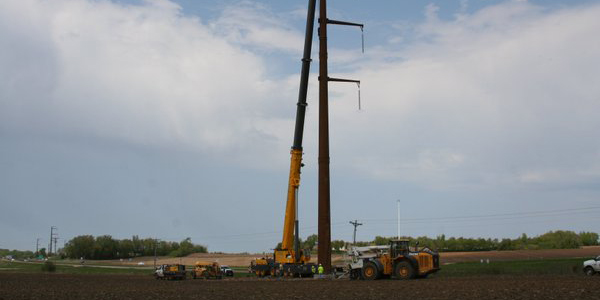By Michael Brooks
FERC on Thursday affirmed an administrative law judge’s decision to assign a Minnesota city’s portion of the 345-kV Hampton-North Rochester line (H-NR) to Northern States Power’s pricing zone, rejecting arguments by NSP parent Xcel Energy (ER14-2154-006, ER15-277-005).
The H-NR line was completed in September 2016 as part of the Hampton-Rochester-La Crosse (HRL) transmission project into Wisconsin. The city of Rochester, Minn., through its Rochester Public Utilities (RPU) municipal utility, owns 14.7% of the line; NSP, Southern Minnesota Municipal Power Agency (SMMPA) and Dairyland Power Cooperative are co-owners, at 49.5%, 23.4% and 12.4%, respectively.
The line was included in MISO’s 2008 Transmission Expansion Plan, and the RTO asked FERC in 2014 to add RPU as a transmission owner in NSP’s zone, where the line is located, enabling the city to receive its annual transmission revenue requirement (ATRR) for the line from the zone.
MISO’s Tariff specifies that within each zone, transmission rates are based on the sum of the revenue requirements for facilities “located within that pricing zone.” Xcel argued that the language did not refer to the facilities’ physical locations, but rather the zones the facilities’ ATRRs are “allocated” to for ratemaking purposes. The company pointed out that the word “physically” does not precede the word “located” in the language. Thus, Xcel argued, the Tariff does not mandate that H-NR should allocated to NSP’s zone.
In his initial decision in May 2017, ALJ David H. Coffman found this unpersuasive, pointing to the dictionary definition of “located.”
“The plain meanings of the terms ‘located’ and ‘allocated’ are not remotely similar,” he wrote.
Xcel took exception to the ALJ using dictionary definitions to support his conclusions. But the commission said Coffman was merely using them as evidence of common sense interpretation of the words.
“We are unpersuaded by arguments seeking to differentiate the use of the word ‘located’ in different contexts with respect to the interpretation of” the Tariff, FERC said. “Such arguments stray from the ordinary meaning of the word and also introduce additional problems, notably different interpretations of the word ‘zones’ with respect to the location of load and the location of transmission facilities. …
“Transmission facilities are not ethereal concepts but fixtures that cannot be moved from zone to zone,” FERC added. “Accordingly, given this context, interpreting the word ‘located’ as ‘existing in a particular place’ is logical.”
Xcel also argued that because Dairyland was allowed to allocate its ATRR for both H-NR and HRL to its own zone, where its load is located, RPU’s ATRR need not be allocated to NSP’s zone. Rather, it could have been allocated to SMMPA’s zone, where RPU’s transmission facilities and load are located.
The ALJ, however, noted that the MISO Tariff allows an exception if the TOs agree upon a different allocation and FERC approves the agreement, as occurred in February 2017 for HRL. (See FERC OKs Settlement, Opens Docket in Dispute over Minn.-Wis. Tx. Project.) That agreement excluded the ATRR allocation for H-NR, which could not be resolved at the time.
JPZ Agreement Dispute
In a related order, FERC ended its examination of the joint pricing zone (JPZ) agreement among TOs in NSP’s zone, after NSP added RPU as a party to the agreement pending the resolution of the ATRR dispute (EL17-44). NSP had balked at adding RPU even after FERC approved it as a MISO TO. The commission had warned in February 2017, when it began its investigation, that revisions to the MISO Tariff or Transmission Owners Agreement (TOA) could be necessary to prevent such exclusions in the future.
Under the TOA, MISO distributes revenue to each JPZ’s host TO, which then distributes it among each TO in its zone. The RTO had been distributing revenue to NSP based on RPU’s approval as a TO in the zone, but because NSP had not added RPU to the agreement, the company was withholding the city’s revenue.
While RPU acknowledged that its situation had been resolved, it told FERC that the TOA gives host TOs “the opportunity to leverage the need for a JPZ agreement against a new, typically smaller, transmission owner seeking to recover some or all of its transmission revenue requirement from that zone.”
“This leverage is often coupled with claims of undue cost shifts and various allegations of unjust and unreasonable rate impacts or cost allocations to make it difficult for a smaller transmission owner such as RPU to integrate into MISO,” RPU said.
FERC disagreed. “There is neither evidence that such denial, or use of that threat to affect the terms of cost allocation, is widespread, nor evidence that the host transmission owner responsibilities have either precluded new transmission owners from receiving their respective ATRRs that have been accepted by the commission or would have a chilling effect on new transmission owners’ interest in joining MISO, as RPU suggests.”
The commission, however, reiterated that “a JPZ agreement should reflect commission-accepted transmission rates. … Therefore, any dispute associated with a new transmission owner’s ATRR should not delay the filing of a JPZ agreement to include a new transmission owner to the zone.”
Chairman Kevin McIntyre recused himself from both orders.



